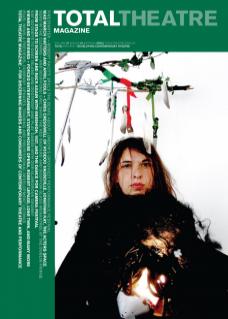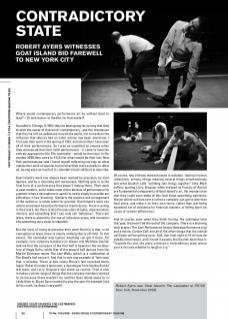Where would contemporary performance art be without Goat Island? – Or new dance, or theatre, for that matter?
Founded in Chicago in 1987, they’ve been going for so long that they stretch the sense of that word ‘contemporary’, and the impression that they’ve left on audiences around the world, not to mention the influence that they’ve had on other artists, has been enormous. I first saw their work in the spring of 1991, and since then I have seen all of their performances. So I was as unsettled as anyone when they announced that their ninth performance – it came to have the entirely appropriate title The Lastmaker – would be their last. In November 2008 they came to PS122 for what would be their last New York performances, and I found myself reflecting not only on what makes their work so special, but on what their work actually is. After all, having seen so much of it, I shouldn’t find it difficult to describe.
Goat Island’s work has always been marked by precision, by intelligence, and by a charming self-awareness. Nothing gets in to the final form of a performance that doesn’t belong there. Their work is post-modern, and it takes none of the devices of performance for granted: when a microphone is used it is rarely simply to provide amplification, it has ‘meaning’. Similarly the position and arrangement of the audience is rarely taken for granted. Goat Island’s work sits where movement-based performance meets dance. There is acting in their work, but there is also the execution of tasks, impersonation, mimicry, and something that I can only call ‘behaviour’. There are jokes, there is absurdity, the use of ridiculous props, and occasionally something very close to slapstick.
But the irony of trying to describe their work like this is that, in its conception at least, there is clearly nothing that is off-limit. To this extent, The Lastmaker was typical. Anything can get in there. For example, core company members Lin Hixson and Matthew Goulish told me that the structure of the first half is based on the architecture of Hagia Sofia, while that of the second half derives from the Martin Scorsese movie The Last Waltz, which is a celebration of The Band’s last concert. And that is only one example of ‘last-ness’ that it includes. There is also Lenny Bruce’s last recorded monologue; Robert Creeley’s last poem; a monologue from Stanley Kunitz’ last book; and Larry Grayson’s last stand-up routine. Then it also includes a whole range of things that the company members wanted to do because there wouldn’t be another Goat Island piece to include them in: Bryan Saner wanted to play the saw, for example (and to his credit, he does it very well).
Of course, few of these elements exist in isolation. Internal rhymes, reflections, echoes, things meaning several things simultaneously, and what Goulish calls “colliding two things together” (like Mark Jeffery quoting Larry Grayson while dressed as Francis of Assisi) are fundamental components of Goat Island’s art. No wonder then that they could even make of this final show something optimistic. Hixson points out how rare it is that a company can get to plan their final piece, and make it on their own terms, rather than just being squeezed out of existence for financial reasons, or falling apart because of ‘artistic differences’.
And of course, even when they finish touring The Lastmaker later this year, that won’t be the end of the company. There is a stunning web project The Last Performance (www.thelastperformance.org) and a movie, Curtain Call, and all of the other things that the individual Goats will be getting up to. Still, that final night at PS122 was decidedly bittersweet, and I found it exactly like Goulish describes it: “Towards the end, the piece achieves a contradictory state where you’re not sure whether to laugh or cry.”
Robert Ayers saw Goat Island’s The Lastmaker at PS122, New York, November 2008.

